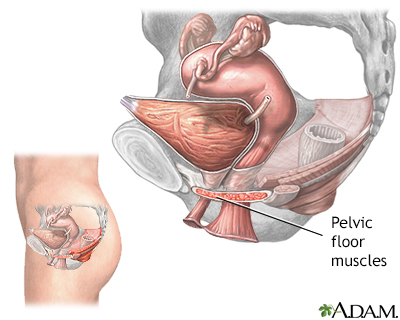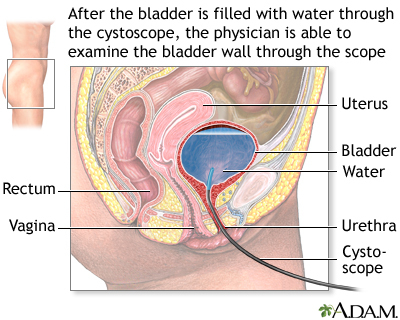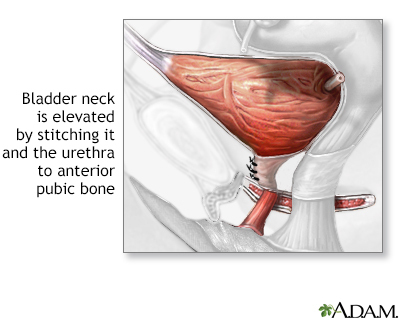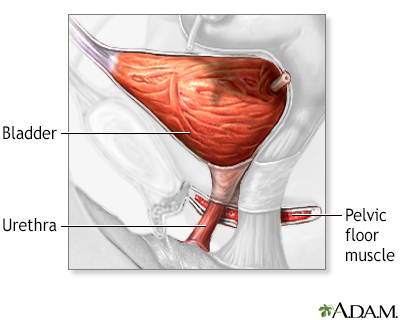Prostate Cancer Awareness Month — Restoring Normalcy
After cancer surgery to remove his prostate about five years ago, Bernard Cancel faced a frustrating dilemma common to men in his situation — male stress…

Update your location to show providers, locations, and services closest to you.
Stress urinary incontinence occurs when your bladder leaks urine during physical activity or exertion. It may happen when you cough, sneeze, lift something heavy, change positions, or exercise.
Incontinence - stress; Bladder incontinence stress; Pelvic prolapse - stress incontinence; Stress incontinence; Leakage of urine - stress incontinence; Urinary leakage - stress incontinence; Pelvic floor - stress incontinence
Stress incontinence occurs when the tissue that supports your urethra gets weak.

When either set of muscles become weak, urine can pass when pressure is placed on your bladder. You may notice it when you:
Weakened muscles may be caused by:
Stress incontinence is common in women. Some things increase your risk, such as:
The main symptom of stress incontinence is leaking urine when you:
Your health care provider will perform a physical exam. This will include:
Tests may include:

Treatment depends on how your symptoms affect your life.
There are 3 types of treatment for stress incontinence:
There are no medicines for treatment of stress incontinence. Some providers may prescribe a medicine called duloxetine. This medicine is not approved by FDA for the treatment of stress incontinence.
BEHAVIOR CHANGES
Making these changes may help:
BLADDER TRAINING
Bladder training may help you control your bladder. The person is asked to urinate at regular intervals. Slowly, the time interval is increased. This causes the bladder to stretch and hold more urine.
PELVIC FLOOR MUSCLE TRAINING
There are different ways to strengthen the muscles in your pelvic floor.
SURGERIES
If other treatments do not work, your provider may suggest surgery. Surgery may help if you have bothersome stress incontinence. Most providers suggest surgery only after trying conservative treatments.
Getting better takes time, so try to be patient. Symptoms most often get better with nonsurgical treatments. However, they will not cure stress incontinence. Surgery can cure most people of stress incontinence.
Treatment does not work as well if you have:
Physical complications are rare and most often mild. They can include:
The condition may get in the way of social activities, careers, and relationships. It also may lead to:
Complications associated with surgery include:
Contact your provider if you have symptoms of stress incontinence and they bother you.
Doing Kegel exercises may help prevent symptoms. Women may want to do Kegels during and after pregnancy to help prevent incontinence.






Al-Mousa RT, Hashim H. Evaluation and management of men with urinary incontinence. In: Partin AW, Dmochowski RR, Kavoussi LR, Peters CA, eds. Campbell-Walsh-Wein Urology. 12th ed. Philadelphia, PA: Elsevier; 2021:chap 113.
Kobashi KC, Albo ME, Dmochowski RR, et al. Surgical treatment of female stress urinary incontinence: aua/sufu guideline. J Urol. 2017;198(4):875-883. PMID: 28625508 pubmed.ncbi.nlm.nih.gov/28625508/.
Lucioni A, Kobashi KC. Evaluation and management of women with urinary incontinence and pelvic prolapse. In: Partin AW, Dmochowski RR, Kavoussi LR, Peters CA, eds. Campbell-Walsh-Wein Urology. 12th ed. Philadelphia, PA: Elsevier; 2021:chap 112.
Patton S, Bassaly RM. Urinary incontinence. In: Kellerman RD, Rakel DP, eds. Conn's Current Therapy 2022. Philadelphia, PA: Elsevier; 2022:1152-1154.
Resnick NM. Urinary incontinence. In: Goldman L, Schafer AI, eds. Goldman-Cecil Medicine. 26th ed. Philadelphia, PA: Elsevier; 2020:chap 23.




After cancer surgery to remove his prostate about five years ago, Bernard Cancel faced a frustrating dilemma common to men in his situation — male stress…
